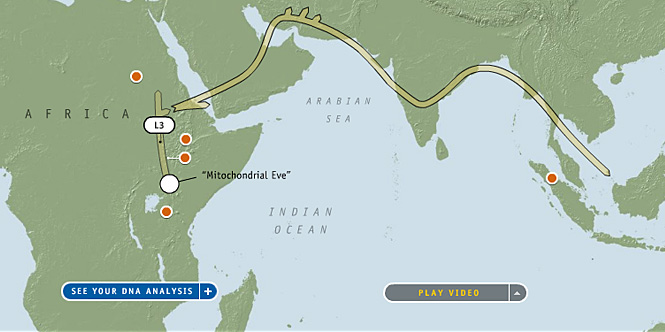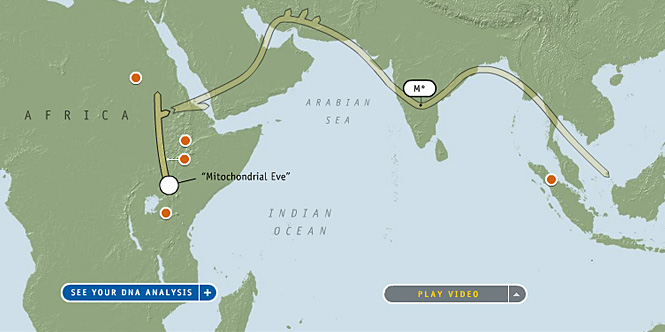
L3
“Mitochondrial Eve,” the common ancestor of all living humans, was born in Africa some 150,000 years ago. All existing MtDNA diversity began with Eve and it remains greatest, and subsequently oldest, in Africa.
Y chromosome polymorphisms on the male line of descent also point to an African origin for all humans, but our male common ancestor, “Adam,” lived only about 60,000 years ago.
MtDNA and the Y chromosome are independent parts of our genetic makeup and each tells a different tale of successive genetic mutations over the eons. That is why their approximate coalescence points are different. Yet while the dates vary, both paths point emphatically to a surprisingly recent African origin for all humans.
The oldest known fossil remains of anatomically modern humans were found in Ethiopia’s Omo River Valley. The skeletons, known as Omo I and Omo II, have been dated to about 195,000 years ago.
Although haplogroup L3 does not appear outside of Africa it is an important part of the human migrations from that continent to the rest of the world.
A single person of the L3 lineage gave rise to the M and N haplogroups some 80,000 years ago.
All Eurasian mtDNA lineages are subsequently descended from these two groups.
The African Ice Age was characterized by drought rather than by cold. But about 50,000 years ago a period of warmer temperatures and moist climate made even parts of the arid Sahara habitable. The climatic shift likely spurred hunter-gatherer migrations into a steppe-like Sahara—and beyond.
This “Saharan Gateway” led humans out of Africa to the Middle East. The route they took is uncertain. They may have traveled north down the Nile to the Mediterranean coast and the Sinai. Alternatively, they may have crossed what was then a land bridge connecting the Bab al Mandab to Arabia, after which they either skirted the then-lush, verdant eastern coast of the Red Sea or headed east along the Gulf of Aden towards the Arabian Sea.
When the climate again turned arid, expanding Saharan sands slammed the Saharan Gateway shut. The desert was at its driest between 20,000 and 40,000 years ago, and during this period Middle East migrants became isolated from Africa.
From their new Middle East location, however, they would go on to populate much of the world.

M*
M is a macro-haplogroup whose various sub groups are found in Eastern Eurasia, East Asia (M7, M8), America (C, D), and the Indian subcontinent—though not in Europe.
The M lineage arose from the African haplogroup defined by L3. With haplogroup N, this lineage traces the first human migrations out of Africa.
Haplogroup M ancestors were part of a great coastal migration that took place some 50,000 years ago. Hunter-gatherers skilled at seaside living wandered along the coasts of the southern Arabian Peninsula, India, Sri Lanka, and Southeast Asia.
This ancient southern coastline was drowned by rising sea levels at the end of the last ice age. The rising waters also swallowed most archaeological traces of these early coastal-dwelling peoples.
Yet in places their physical footprint endures. Some of the fast-moving migrants reached and populated distant Australia soon after leaving Africa. Australian archaeological evidence, such as rock art, confirms their presence as early as 40,000 or perhaps even 60,000 years ago.
During the glacial Pleistocene era (about 50,000 years ago) sea levels in some places were 330 feet (100 meters) lower than they are today. The landmass known as Sunda (comprised of modern Sumatra and Borneo) was separated by just 62 miles (100 kilometers) of open water from Sahul, a second landmass comprised of Australia, New Guinea and Tasmania.
Though Australia was never connected to the continent by a land bridge, such short stretches of relatively calm water were apparently navigable by these early seafarers.
Haplogroup M is a broad group comprised of many as-yet undefined branches. Learning more about such lineages will add further clarity to the big picture of human genetic diversity, and is a primary goal of the Genographic Project.
§






